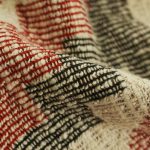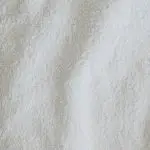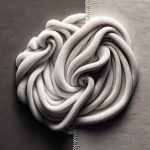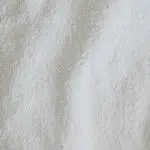When considering terry cloth fabrics for hot and humid conditions, you might wonder about their effectiveness. These materials boast absorbent and breathable qualities that can keep you cool. However, in high humidity, they can also trap moisture, leading to discomfort. It’s essential to understand how to choose the right type of terry cloth to maximize its benefits while avoiding potential drawbacks. Let’s explore the various factors that influence their performance in warm weather.
Table of Contents
Key Takeaways
- Terry cloth is highly absorbent, effectively wicking moisture away and keeping the body cool in hot weather.
- The looped texture allows for airflow, promoting breathability in warm conditions.
- However, terry cloth can feel heavy and damp in humid environments, potentially restricting movement.
- It may take longer to dry, risking bacteria growth in high humidity.
- Lightweight cotton blends or quick-dry options are recommended for better comfort in hot and humid conditions.
Properties of Terry Cloth
Terry cloth, with its distinctive loops, offers unique properties that make it ideal for hot and humid conditions. The looped texture enhances its absorbency, allowing it to soak up moisture quickly.
When you wear or use terry cloth, you’ll notice how effectively it wicks sweat away from your skin, keeping you feeling dry and comfortable. Additionally, its breathable nature guarantees air circulation, preventing overheating.
The soft, plush feel adds to your comfort, making it a popular choice for towels and clothing alike. Terry cloth’s durability means it can withstand frequent washing, maintaining its functionality over time.
Types of Terry Cloth Fabrics
When selecting the right fabric for your needs, understanding the different types of terry cloth can make a significant difference.
Here are four common types to evaluate:
- Cotton Terry: Soft and absorbent, perfect for towels and bathrobes.
- Polyester Terry: Durable and quick-drying, ideal for athletic wear and swim cover-ups.
- Bamboo Terry: Eco-friendly and naturally antibacterial, great for sensitive skin.
- Microfiber Terry: Lightweight and ultra-absorbent, suitable for cleaning and drying applications.
Each type has unique benefits that cater to various needs, so think about what’ll work best for you in hot and humid conditions.
Choosing the right terry cloth can enhance your comfort and functionality.
Performance in Hot Weather
Choosing the right terry cloth can make all the difference in how you feel during hot weather. When temperatures soar, lightweight and breathable terry cloth options are key.
These fabrics allow for better air circulation, helping to wick moisture away from your skin, keeping you cool and comfortable. Terry cloth’s unique looped texture absorbs sweat efficiently, which is essential when you’re active in the heat.
Look for terry cloth made from natural fibers like cotton, as they tend to be more breathable and softer against your skin. Avoid heavier, thicker varieties that can trap heat, making you feel sticky and uncomfortable.
With the right choice, you’ll enjoy a more pleasant experience, even on the hottest days.
Comparison With Other Fabrics
When choosing fabrics for hot and humid weather, it’s important to compare terry cloth with other options like linen, synthetic materials, and bamboo.
Each fabric has unique properties that can affect comfort and performance.
Let’s break down how terry cloth stacks up against these alternatives.
Terry vs. Linen Properties
While both terry and linen fabrics serve distinct purposes, understanding their properties can help you make an informed choice for hot and humid conditions.
Here’s a quick comparison:
- Breathability: Linen excels in breathability, allowing air to flow freely, keeping you cool.
- Moisture Absorption: Terry fabric is great for absorbing moisture, making it perfect for towels, but it can feel heavier.
- Drying Time: Linen dries faster than terry, which can be beneficial in humid environments.
- Softness: Terry is plush and soft against the skin, while linen can be slightly coarse, offering a different texture experience.
Choosing between them depends on your specific needs, whether you prioritize comfort, moisture management, or quick drying in hot conditions.
Synthetic Fabrics Overview
Synthetic fabrics have gained popularity for their unique properties, particularly in hot and humid conditions. Unlike natural fabrics like cotton or linen, synthetic materials such as polyester and nylon are designed to wick moisture away from your skin, keeping you dry.
They’re lightweight and quick-drying, which makes them ideal for active wear during warm weather. While cotton absorbs moisture, it can become heavy and uncomfortable when wet.
Additionally, synthetic fabrics often offer better durability and resistance to wrinkles, which is a plus for those on the go. However, they may not be as breathable as natural fibers, leading to potential discomfort in extreme heat.
Balancing these factors is essential when choosing the right fabric for your needs.
Bamboo Fabric Comparison
Bamboo fabric stands out as a notable option when compared to traditional materials like cotton and linen. It offers several advantages that make it ideal for hot and humid conditions:
- Breathability: Bamboo fabric allows air to circulate, keeping you cool and comfortable.
- Moisture-wicking: It effectively pulls moisture away from your skin, ensuring you stay dry.
- Antimicrobial properties: Bamboo naturally resists bacteria, reducing odor and irritation.
- Softness: This fabric feels incredibly soft against your skin, enhancing your overall comfort.
In contrast, cotton can retain moisture and linen might wrinkle easily.
Choosing bamboo fabric can provide you with a more pleasant experience in those sweltering summer days.
Care and Maintenance
Taking care of your terry cloth fabrics is essential for keeping them in great shape.
You’ll want to follow specific washing instructions and consider the best drying methods to prevent damage.
Plus, knowing the right storage techniques can help maintain their softness and longevity.
Washing Instructions and Tips
Although caring for terry cloth fabrics is straightforward, knowing the right washing instructions can greatly extend their lifespan.
Follow these tips to keep your terry cloth items looking great:
- Wash in cold or warm water: Hot water can damage the fibers, so stick to cooler temperatures.
- Use a mild detergent: Harsh chemicals can break down the fabric, so choose a gentle detergent.
- Avoid bleach: It can fade colors and weaken the fibers, so steer clear when washing.
- Separate colors: Always wash darks and lights separately to prevent color bleeding.
Drying Methods to Consider
When it comes to drying terry cloth fabrics, you have several effective methods to choose from that will help maintain their softness and absorbency.
The quickest way is tossing them in the dryer on a low heat setting. This method guarantees they dry evenly while retaining fluffiness.
Alternatively, air drying is a great option, especially in hot, humid conditions. Simply hang them outside or lay them flat on a clean surface, allowing natural airflow to do the work. Just be cautious of direct sunlight, which can fade colors over time.
Whichever method you choose, avoid high heat, as it can damage the fibers and reduce absorbency.
Regularly check your terry cloth to confirm it’s completely dry before storing it.
Proper Storage Techniques
Proper storage techniques are essential for maintaining the quality and longevity of your terry cloth fabrics.
To keep them in top shape, follow these steps:
- Clean Before Storing: Always wash and dry your terry cloth items before putting them away to prevent mildew and odors.
- Choose the Right Location: Store them in a cool, dry place away from direct sunlight to avoid fading and deterioration.
- Use Breathable Storage: Opt for cotton bags or bins with ventilation instead of plastic, which can trap moisture.
- Avoid Heavy Weights: Don’t pile heavy items on top, as this can compress the fabric and affect its texture.
Sustainability and Eco-Friendliness
As the demand for sustainable textiles grows, Terry cloth fabrics are stepping up to meet eco-friendly standards. You’ll find that many manufacturers are now using organic cotton or recycled materials to create Terry cloth, reducing their environmental footprint.
By choosing Terry cloth made from these sustainable sources, you’re supporting eco-conscious practices.
Additionally, the durability of Terry cloth means it lasts longer, which decreases the need for frequent replacements. This longevity not only saves you money but also minimizes waste.
When you wash Terry cloth, it generally requires less energy compared to other fabrics, further enhancing its eco-friendliness.
Advantages of Terry Cloth in Warm Conditions
Choosing sustainable Terry cloth not only benefits the environment but also provides unique advantages in warm conditions.
You’ll find this fabric exceptionally suited for hot weather due to its qualities:
- Absorbency: Terry cloth absorbs moisture effectively, keeping you cool and comfortable.
- Breathability: The looped texture promotes airflow, which helps regulate your body temperature.
- Softness: Its plush feel against your skin offers a cozy experience, making it perfect for lounging or beach days.
- Durability: Terry cloth withstands frequent use and washing, ensuring it lasts through the summer season.
These benefits make Terry cloth a great choice for your warm-weather wardrobe, enhancing your comfort while being kind to the planet.
Limitations of Terry Cloth for Humid Environments
While Terry cloth offers many benefits in warm conditions, it also has limitations when faced with high humidity. One major issue is its absorbency; Terry cloth tends to trap moisture, making it feel damp and heavy against your skin. This can lead to discomfort, especially if you’re sweating.
Additionally, the thick fibers can take longer to dry, which can create a breeding ground for bacteria and odors. You might also find that the fabric clings to your body, restricting movement and airflow.
Ultimately, if you’re looking for lightweight options, Terry cloth isn’t the best choice, as its bulkiness can weigh you down. Overall, while it has its perks, Terry cloth mightn’t be ideal for extremely humid environments.
Recommendations for Choosing Terry Cloth Products
When you’re selecting Terry cloth products for hot and humid conditions, it’s essential to contemplate both fabric weight and fiber composition.
Here are some recommendations to help you make the best choice:
- Opt for Lightweight Options: Choose terry cloth that’s lightweight to guarantee breathability and comfort.
- Look for Cotton Blends: Products made from cotton blends can enhance moisture-wicking properties.
- Check for Looser Weaves: A looser weave allows air circulation, reducing that sticky feeling in humidity.
- Prioritize Quick-Dry Features: Select items labeled as quick-drying to help manage sweat and humidity effectively.
Frequently Asked Questions
Can Terry Cloth Cause Skin Irritation in Humid Weather?
Terry cloth can cause skin irritation in humid weather if it traps moisture against your skin. If you notice discomfort, consider switching to more breathable fabrics that allow better air circulation and moisture wicking.
How Does Terry Cloth Compare to Cotton in Hot Conditions?
While terry cloth’s thick texture traps heat, cotton’s lightweight, breathable nature keeps you cooler. In hot conditions, you’ll find cotton’s moisture-wicking properties more pleasant, letting you feel refreshed while terry cloth may feel stifling.
Is Terry Cloth Suitable for Children in Hot Climates?
Terry cloth isn’t always the best choice for children in hot climates. It can trap heat and moisture. Instead, consider lightweight, breathable fabrics that keep your kids cool and comfortable during those sweltering days.
What Are the Best Uses for Terry Cloth in Summer?
Terry cloth’s absorbency makes it great for beach towels, bathrobes, and casual summer wear. It keeps you comfortable and dry after swimming or sunbathing, so you can enjoy those hot days without feeling weighed down.
Can Terry Cloth Be Layered for Added Warmth in Cool Weather?
Yes, you can layer terry cloth for added warmth in cool weather. Its absorbent nature helps trap heat, making it a cozy choice. Just make sure you balance it with other fabrics for maximum comfort.
- Can a Dog Tear Kevlar Fabric? Understanding Its Strength - June 21, 2025
- Camouflage Kevlar Fabric: Military-Grade Tactical Gear - June 21, 2025
- Buying Kevlar Fabric in Europe: A Buyer’s Checklist - June 21, 2025







